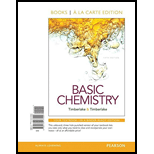
Concept explainers
(a)
Interpretation:
Need to comprehend the amino acids in N-terminus in the given sequence of decapeptide.
Concept Introduction:
Proteins are
(b)
Interpretation:
Need to comprehend the amino acids in C-terminus in the given sequence of decapeptide.
Concept Introduction:
Proteins are biomolecules which are composed of amino acids. Here amino acids are the monomer organic molecules which are composed of two main functional groups; -NH2 and −COOH group. Since −NH2 is a basic group and exist as −NH3+ and −COOH is an acidic group exist as −COO- therefore overall the amino acid molecules are neutral. If any other functional group is present in the side chain of the amino acid, that will determine the acidic and basic nature as well as polarity of molecule.
(c)
Interpretation:
Need to comprehend the non-polar amino acids in the given sequence of decapeptide.
Concept Introduction:
Proteins are biomolecules which are composed of amino acids. Here amino acids are the monomer organic molecules which are composed of two main functional groups; -NH2 and −COOH group. Since −NH2 is a basic group and exist as −NH3+ and −COOH is an acidic group exist as −COO- therefore overall the amino acid molecules are neutral. If any other functional group is present in the side chain of the amino acid, that will determine the acidic and basic nature as well as polarity of molecule.
(d)
Interpretation:
The condensed structural formulas at physiological pH for the acidic and basic amino acids in GnRF should be drawn.
Concept Introduction:
Proteins are biomolecules which are composed of amino acids. Here amino acids are the monomer organic molecules which are composed of two main functional groups; -NH2 and −COOH group. Since −NH2 is a basic group and exist as −NH3+ and −COOH is an acidic group exist as −COO- therefore overall the amino acid molecules are neutral. If any other functional group is present in the side chain of the amino acid, that will determine the acidic and basic nature as well as polarity of molecule.
(e)
Interpretation:
The condensed structural formulas for the primary structure of the first three amino acids that are starting from the N-terminus of GnRF at physiological pH should be drawn.
Concept Introduction:
Proteins are biomolecules which are composed of amino acids. Here amino acids are the monomer organic molecules which are composed of two main functional groups; -NH2 and −COOH group. Since −NH2 is a basic group and exist as −NH3+ and −COOH is an acidic group exist as −COO- therefore overall the amino acid molecules are neutral. If any other functional group is present in the side chain of the amino acid, that will determine the acidic and basic nature as well as polarity of molecule.
Want to see the full answer?
Check out a sample textbook solution
Chapter 18 Solutions
Basic Chemistry, Books a la Carte Edition (5th Edition)
 ChemistryChemistryISBN:9781305957404Author:Steven S. Zumdahl, Susan A. Zumdahl, Donald J. DeCostePublisher:Cengage Learning
ChemistryChemistryISBN:9781305957404Author:Steven S. Zumdahl, Susan A. Zumdahl, Donald J. DeCostePublisher:Cengage Learning ChemistryChemistryISBN:9781259911156Author:Raymond Chang Dr., Jason Overby ProfessorPublisher:McGraw-Hill Education
ChemistryChemistryISBN:9781259911156Author:Raymond Chang Dr., Jason Overby ProfessorPublisher:McGraw-Hill Education Principles of Instrumental AnalysisChemistryISBN:9781305577213Author:Douglas A. Skoog, F. James Holler, Stanley R. CrouchPublisher:Cengage Learning
Principles of Instrumental AnalysisChemistryISBN:9781305577213Author:Douglas A. Skoog, F. James Holler, Stanley R. CrouchPublisher:Cengage Learning Organic ChemistryChemistryISBN:9780078021558Author:Janice Gorzynski Smith Dr.Publisher:McGraw-Hill Education
Organic ChemistryChemistryISBN:9780078021558Author:Janice Gorzynski Smith Dr.Publisher:McGraw-Hill Education Chemistry: Principles and ReactionsChemistryISBN:9781305079373Author:William L. Masterton, Cecile N. HurleyPublisher:Cengage Learning
Chemistry: Principles and ReactionsChemistryISBN:9781305079373Author:William L. Masterton, Cecile N. HurleyPublisher:Cengage Learning Elementary Principles of Chemical Processes, Bind...ChemistryISBN:9781118431221Author:Richard M. Felder, Ronald W. Rousseau, Lisa G. BullardPublisher:WILEY
Elementary Principles of Chemical Processes, Bind...ChemistryISBN:9781118431221Author:Richard M. Felder, Ronald W. Rousseau, Lisa G. BullardPublisher:WILEY





